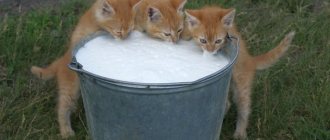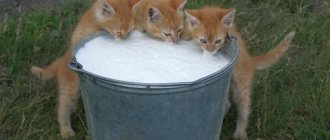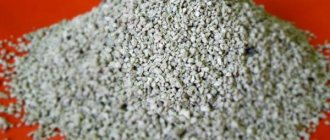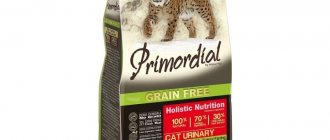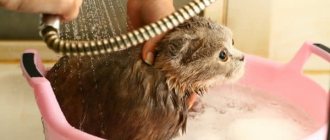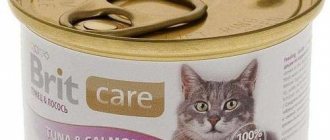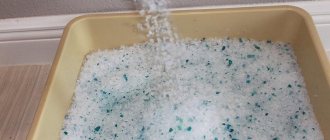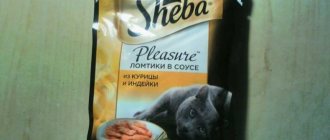As soon as kittens, like any other children, are born, they need to feed on their mother's milk. On the first day after birth, the kitten eats colostrum.
But the cat does not always produce milk afterwards. In this case, feeding the kittens falls on the shoulders of the owners.
Making cat milk replacer at home is quite simple - you can rely on yourself, you can buy special food.
Composition of cat milk
Cat's milk contains all the components found in human and cow's milk, but the nutritional properties differ.
Cat milk consists of 70% water, and its fat content is no more than 11%. Human, goat and cow milk has 7% more fat content than cat milk.
Cat milk contains 11% proteins (for comparison, human milk contains 2%, and goat and cow milk contains 4%).
But the milk of ungulates and humans contains a lot of lactose. The composition of non-cat milk is not suitable for kittens. They can be fed with milk other than their own, but they may get sick in the future.
Beaphar Kitty-Milk - the best milk powder for kittens
Complete food from the famous manufacturer Beaphar (Netherlands) for artificially fed kittens. Milk formula for kittens contains the necessary protein and fat content. Kitty-Milk is as close as possible to cat's mother's milk in terms of the content of micro- and macroelements. Suitable for kittens from birth to 35 days of age.
Ingredients: milk and whey, fats, oils. The product is enriched with vitamins: A, B1, B2, B6, B12, C, D3. Contains: choline, lysine, pantothenic acid, nicotinamide, calcium, phosphorus, sodium, iron, zinc, manganese, copper, selenium, iodine, magnesium, taurine, Omega-3, Omega-6.
Dosage: 2 scoops of powder (7 g) thoroughly mixed with a whisk in 50 g. warm water. The finished mixture can be stored in the refrigerator for up to 8 hours. When using, heat to 35-40°C.
- Plus: can be used for additional feeding of pregnant and lactating cats.
- Cons: high price.
Price: pack 200 gr. – 665 rub., 500 gr. – 1673 rub. More details about the product
What to feed a kitten if the cat does not have her own milk
The mixture must contain vitamins, minerals and trace elements.
Read here Wet food for cats - rating of the best foods, an overview of their compositions and reviews of veterinarians (120 photos)
Complete milk substitutes for kittens are produced by well-known manufacturers of food for adult cats: Jimborn, Trixie, Royal Canin cat milk replacer is in demand, Jimpet and Beafar are also popular among cat lovers.
Royal Canin, Jimpet and Biafar are considered the best. Even photos of packages of cat milk substitutes from these companies already evoke associations with feeding offspring.
And the composition of the mixtures is similar to cat milk - they contain the same breakdown of nutrients as in real cat milk.
APPLICATION
The measuring spoon included in the kit holds 2.5 g, a teaspoon - 5 g, and a tablespoon - 15 g of formula powder. To prepare milk from a milk mixture, you need to dilute 1 part of the powder (g) with 4 parts of boiled water (temperature 50–60°C) (ml = g), stirring until completely dissolved. For example, to prepare 110 ml. milk should be diluted with 30 g of milk mixture (12 measuring spoons) in 85 g of boiled water. Before feeding, you should cool the milk to 38°C and make sure that it is not too hot for your baby by dripping a little onto your inner wrist.
Milk recipes for a kitten
If your cat doesn’t have milk or you have a small kitten at home, you can prepare food from condensed milk without sugar. Usually it is 20% fat.
Mix 5 parts milk with 1 part water and add 1 teaspoon of bone meal per 1 liter of mixture.
Methods and rules for feeding kittens
In any of the above cases, you will need a bottle and nipple (some manufacturers of ready-made cat milk put the bottle and nipple inside a jar of dry formula). They can also be purchased at veterinary pharmacies. You can use a plastic eye dropper or syringe (without a needle). The main requirement is sterility. Bottles and teats should be cleaned and boiled regularly. The food supply is prepared for no more than 24 hours and stored in the refrigerator. The food must be heated to 38 °C, and when giving it, you must ensure that the kitten sucks milk itself. Milk should not be introduced by force, as the baby may choke. When a kitten falls asleep or has milk bubbles coming out of its mouth, it means it is already full. It is important that kittens suckle themselves through the narrow holes in the nipple and prepare themselves for the “drinking work”. Do not give milk through a wide opening. This often leads to milk entering the respiratory tract and causing pneumonia.
- Nutrition of newborn kittens
- Nutrition of newborn kittens
- Nutrition of newborn kittens
It is better to feed kittens by holding them. They, like babies, need to be held in an upright position after feeding so that they can burp, releasing excess air. In the first 2 days of life, it is enough for kittens to give 1 teaspoon of milk every 2 hours. The dose should increase as the animals grow. It is advisable to weigh the kittens every day and keep records. If they aren't gaining weight, that should be a red flag. In the first 3 weeks of life, the kitten should be given 1 teaspoon of artificial food 7-8 times a day (every 2-3 hours, and at night too), with a night break of 5-6 hours. Gradually, the number of feedings should be reduced, increasing the amount of food fed at a time. At the age of 15-20 days, teeth begin to cut and the cat does not have the required amount of milk. From this period, kittens need to be fed, gradually transferring them to regular food. The first feeding includes dairy products (for kittens that have been fed by their mother). You should start with 2 teaspoons of milk, dry, medium fat, diluting it with warm water and adding honey or a pinch of sugar (10 g/l). Gradually, every day you need to increase the amount of milk by 1 spoon. You can also give milk porridge prepared in the same way as for baby food, or as in the example with oatmeal: it is diluted with whole milk with the addition of cream and a chicken egg (all this must be mixed into a homogeneous mass). Dairy products are given from a bowl or from a spoon, and then from a bowl. If your kitten can't figure out how to lap milk, lubricate its mouth with a drop of milk. Your little pet will understand what's going on and will begin to lap from the bowl, and soon, obeying the feeling of hunger, he will eat from the bowl himself. At about the same time, at 3-4 weeks of age, you can gradually feed kittens (both “natural” and “artificial”) with other products or soak a few granules of dry food first in warm milk and then in water. This will depend on the type of feeding you prefer for your pet: natural feeding or feeding commercially prepared food. This must be done at the same time of day. After the first 2 weeks of feeding, you can gradually diversify the menu: 2 times a week, add egg yolk and dry yeast to the milk, give porridge from chicken or fish with rice water, finely chopped or ground beef (lean); cottage cheese and entrails. If the baby has loose stools, regular milk should be replaced with concentrated milk, diluted with warm boiled water in a ratio of 1:2. At the age of 3-5 months, kittens are weaned from their mother and eat baby food until they are one year old. If you have purchased a kitten, be sure to ask the cat’s owner what kind of food he gave to the animals.
Newborn kittens
How to make cat milk replacer? In half a liter of regular milk from a store carton, mix the yolk of a raw chicken egg and add 4 teaspoons of granulated sugar without top.
Goat milk and powdered milk are also suitable. It is fashionable to pour 0.3 ml of Tetravit vitamin drops into the mixture.
- Wet food for cats - rating of the best foods, an overview of their compositions and reviews of veterinarians (120 photos)
Proplan food for cats: analysis of the composition, veterinarian reviews, price and advice on choosing food (105 photos)
- Hills food for cats: review of composition, recommendations for selection and tips for use in the diet (130 photos)
Kittens can also prepare the “Malyutka” formula for children, the preparation instructions are the same as on the package for babies.
For very small and weak kittens, you can prepare food according to this recipe: for 100 ml of cow's milk, take 20 ml of an aqueous solution of glucose, you can feed it this way, but it is better to mix in an egg yolk and 1 teaspoon of refined sunflower oil.
Milk can be replaced with Nutrilon infant formula. You can add vitamin drops to the mixture.
All homemade kitten formulas must be thoroughly mixed - they must be liquid and free of lumps. Kittens are fed from a bottle with a nipple with a small hole; if you have patience, it is better to feed from a pipette.
Another option is to give the milk mixture in portions from a syringe (without a needle). The main thing is that the kitten has time to swallow a portion of food.
It happens that you need a cat milk substitute.
This can happen if the litter is very large and there is not enough mother's milk, if the mother cat has little or no milk, or if the newly born baby is left without a mother. Cow's milk, but better than goat's, can be used if kittens need to be supplemented, but no milk can completely replace cat's milk. If there is a need to feed a motherless kitten, the best choice would be to find a lactating cat. In second place is a dry substitute mixture, which can be purchased at veterinary pharmacies. If none of these options is feasible, you will have to prepare the mixture yourself, and you cannot do without milk additives. Why can't you just use cow's or goat's milk, and what should you add to it to make it look like cat's milk? Why cat milk is unique
Each animal's milk is suitable for its babies. Cow's milk contains an ideal set of substances for a calf, goat's milk for a kid, etc. Cat milk is ideal for a kitten.
The fat content of cat's milk is very high - on average 9%. The highest lipid content in colostrum is up to 11%. Every day of lactation the amount of protein increases, which is due to the predatory nature of the cat. Per 100 grams of milk there are from 7 to 11 grams of proteins. The longer milk is produced, the more minerals it contains; only iron remains at approximately the same level - about 0.004 mg per milliliter. In the first two days, kittens receive 0.5 mg of calcium with each milliliter of milk, after a week - 1.3 mg, after a month - 1.8 mg. The same volume contains 1.62 mg of phosphorus. The amount of magnesium in 20 days increases from 0.085 mg to 0.105 mg, zinc - from 0.0045 mg to 0.074 mg. The average copper content is 0.11 mg per 100 grams, potassium is 103 mg. The energy value of cat milk can reach up to 120 kcal. Carbohydrates are represented by lactose in an amount of 3.4-4%.
Since in the first days of life the only food for the cubs is milk, it must contain all the necessary substances, including essential amino acids.
For a cat, these are arginine, histidine, isoleucine, leucine, valine, threonine, lysine, phenylalanine, methionine, tryptophan, taurine. For example, taurine in cat milk is 26 mg per 100 grams, methionine – 188 mg, arginine – 347 mg. Is it possible to feed a kitten with cow's or goat's milk?
The protein content in both goat's and cow's milk does not exceed 4%, the fat content is approximately at the same level. One milliliter of cow's milk contains 1.2 mg of calcium and 0.9 mg of phosphorus, goat's milk - 1.43 mg and 0.89 mg, respectively. There is the same amount of magnesium in cow and goat milk - 0.014 mg, zinc - 0.4 mg and 0.41 mg, potassium - 0.146 mg and 0.145 mg, and in terms of copper and iron content, cow's milk is inferior to goat's milk (copper - 0.012 mg and 0.02 mg, iron – 0.067 mg and 0.1 mg). The energy value of goat's milk is 69 kcal, cow's milk is 64 kcal. Lactose in cow's milk is 4.8%, goat's milk - 4.6%.
The content of arginine and methionine in cow and goat milk is the same - 119 mg and 80 mg per 100 grams of product, and the taurine necessary for cats is 4.53 mg in goat milk and 0.2 mg in cow milk. The difference in the amount of other amino acids ranges from 5 to 14% in either direction: there is more isoleucine and lysine in cow's milk, histidine and leucine in goat's milk. There are two to three times more vitamins A and PP in goat's milk than in cow's milk, and B12 is four times less.
Thus, goat or cow milk without any additives cannot satisfy the nutritional needs of a suckling kitten.
How to make formula for a kitten at home
If there is an urgent need to artificially feed a suckling kitten, and there is no special cat milk substitute, you can prepare the food yourself from available products. It is better to use goat's milk. It contains less lactose than cow's milk, and due to the characteristics of proteins and fats, it forms a softer clot in the stomach acid, which is easier to digest. Here are some recipes:
- 250 ml of milk + 2 tablespoons of sugar + 1 yolk of a hard-boiled chicken egg + 0.3 ml of liquid veterinary vitamins “Trivit”;
- 230 ml milk + 1 teaspoon vegetable oil + 1 drop children's multivitamins;
- 100 ml milk + 20 ml glucose 5% + 1 chicken egg yolk + 1 teaspoon vegetable oil + 0.1 ml Trivit vitamins;
- 30 ml milk + 10 g quail eggs + 45 ml cream 10% + 10 ml glucose 5%;
- 60 ml milk + 40 ml cream 20% + 1 chicken egg yolk + 20 ml glucose 5%;
- 236.5 g of milk + 1 teaspoon of vegetable oil + 2 chicken egg yolks + 1 drop of liquid multivitamins.
All of the above artificial mixtures can only be a temporary way out of the situation if the kitten is left orphan, or a means for additional nutrition for babies when there are too many of them in the litter or the mother does not have enough milk. For a baby left without a mother, try to purchase a special dry formula - a cat's milk substitute. Only its composition will provide all the needs of a growing organism.
About the rules for storing food for kittens
Kittens can be fed only warm formula, the temperature should be about 39° C. Unfinished formula can be kept in the refrigerator for a day in a clean container.
- Vitamins for cats against hair loss - expert reviews, the best complexes, products and nutritional supplements for cats (135 photos and videos)
Classes of cat food - classification, comparison and detailed overview of the composition (85 photos and videos)
- Can cats have eggs - boiled, raw eggs and tips on their use in the diet for cats (110 photos)
The dry mixture should be stored in a cool, dark place away from sources of moisture, and diluted only with boiled water at room temperature, and heated for feeding.
The kitten’s immune background is unstable; its gastrointestinal tract should not be exposed to bacterial attacks. And like a child or kitten, you can cook food only with clean hands.
Features of preparing milk mixture
The preparation sequence for all milk replacers for cats is almost the same. Detailed instructions are already printed on the packaging and, as a rule, they are quite detailed and understandable. We will consider just some of the features of using such mixtures :
- First of all, you should not buy a lot of substitute. As a rule, it is not suitable for long-term storage, and using an expired product is dangerous, since pathogenic bacteria form in dry milk during long-term storage;
- your hands and the utensils in which you will prepare the mixture must be sterile. This recommendation especially applies to newborn kittens, because in the first days after birth, their immunity has not yet been fully formed, and the body is very vulnerable to viruses and bacteria;
- The mixture needs to be prepared exactly as much as the kittens will eat at one time. The prepared substitute cannot be stored in the refrigerator;
- You need to clearly understand how much mixture the kitten should eat. Usually the instructions contain tables that can be used to determine which portion is suitable for the animal. However, sometimes it is necessary to individually adjust the dosage of the formula, since both underfeeding and overfeeding are harmful to the baby. You need to monitor your kitten's feces. If the baby is overfed, the droppings will be slightly runny and yellowish. If the kitten’s stool is normal, and after feeding he does not look lethargic and restless, then he is full, and the portion size is chosen correctly.
About food supplies for a kitten
You should not buy mixtures “in reserve”. The kitten will grow up quickly, no need to buy a large bag of formula.
If you look in stores at how much cat milk replacer costs, it will become clear that it is better to purchase Royal Canin products; the food is packaged in sterile “one-time” bags, they can be purchased for future use, and have a long shelf life.
Owners of a small kitten should purchase a bottle and pacifier in advance, as well as suitable food that replaces the cat's milk.
- How to feed a neutered cat - tips on choosing a diet for a sterilized cat at home (90 photos)
Felix food for cats: reviews, composition overview, use in the diet, price and food combinations (125 photos)
What to feed a sterilized cat: video tips on how to properly, what and when to feed a cat after sterilization (125 photos + video)
Using a placeholder
When purchasing such a product, you should understand exactly how it is used without harming the kitten and maintaining all its beneficial properties.
First of all, the mixture must be properly prepared.
Instructions for using substitutes are usually almost identical for all manufacturers.
Cat owners should know the nuances of this process:
- powdered milk is diluted with cool boiled water in the ratio specified on the packaging or in the instructions;
- Sterile containers should be used;
- hands must be washed;
- there is no need to buy large packages of the substitute, because during long-term storage various bacteria can get into it;
- It’s better to throw away what the kitten hasn’t eaten;
- some manufacturers do not include feeding bottles in the kit, so this should be taken care of in advance;
- You cannot feed your pet from a spoon - he may choke. In addition, the kitten can die if some of the food gets into the lungs.
Photos of cat milk substitutes
Help the site, share with friends 
DOSAGE
Dosage for orphaned kittens:
- 100 g - 50 ml. milk
- 200 g - 80 ml. milk
- 400 g - 135 ml. milk
- 600 g - 180 ml. milk
- 1000 g - 250 ml. milk
Number of feedings per day for orphaned kittens:
- 0–21 days – 8–10 feedings (also at night)
- Days 22–28 – 6–8 feedings (1 time at night)
- Days 29–35 – 4–6 feedings (1 time at night)
- Days 36–42 – 3 feedings (daytime only)
- Days 43–49 – up to 3 feedings (daytime only)
From day 36, gradually transfer the kitten to additional solid food.
